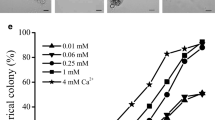Abstract
The growth response of a wild achlorophyllous Euglena gracilis mutant was studied during exposure to cadmium and pentachlorophenol (PCP). Cadmium gradually reduced the growth rate and terminal cell density; PCP only lengthened the initial lag phase relative to control cultures. Flow cytometry showed that cadmium altered the cell cycle by delaying late S and G2/M phases; PCP did not disturb the cell cycle, but markedly affected DNA staining: the intercalating dyes ethidium bromide and propidium iodide showed little staining compared to controls. However, replication and transcription processes were not altered by PCP, as cell division occurred normally. Cells surviving after PCP treatment apparently developed an adaptative response during the lag phase.
Similar content being viewed by others
References
Ahlborg UG, Lindgren JE, Mercier M (1974) Metabolism of pentachlorophenol. Arch Toxicol 32:271–281
Alleman BC, Logan BE, Gilberton RL (1992) Toxicity of pentachlorophenol to six species of white rot fungi as a function of chemical dose. Appl Environ Microbiol 58(12):4048–4050
Anonymous (1987) National pesticide use analyzed. Alternative Agric News 5:1–4
Bartkowiak J, Kapuscinski J, Melamed R, Darzynkiewicz Z (1989) Selective displacement of nuclear proteins by antitumour drugs having affinity for nucleic acids. Proceed Nat Acad Sc 86:5151–5154
BenBassat D, Gedalia S, Nachman G, Hillei J (1972) Growth of Chlamydomonas in a medium containing mercury. Nature 240:43–44
BenBassat D, Mayer AM (1975) Volatilization of mercury by algae. Physiol Plant 33:128–132
Bonaly J, Bariaud A, Duret S, Mestre JC (1980) Cadmium cytotoxicity and variation in nuclear content of DNA in Euglena gracilis. Physiol Plant 49:286–290
Bonaly J, Bre MH, Lefort-Tran M, Mestre JC (1987) A flow cytometric study of DNA staining in situ in exponentially growing and stationary Euglena gracilis. Cytometry 8:42–45
Bonaly J, Delcourt A, Mestre JC (1978) The effects of some metallic ions on the growth of Chlamydomonas variabilis and Euglena gracilis. Mitt Internat Verein Limnol 21:103–109
Bonaly J, Miginiac-Maslow M, Brochiero E, Hoarau A, Mestre JC (1986) Cadmium effects on the energetics of Euglena during the development of cadmium resistance. J Plant Physiol 123:349–358
Braun WH, Blau GE, Chenoweth MB (1979) The metabolism pharmacokinetics of pentachlorophenol in man and a comparison with the rat and monkey. Dev Toxicol Environ Sci 4:289–296
Bochiero E, Bonaly J, Mestre JC (1984) Toxic action of hexavalent chromium on Euglena gracilis cells strain Z grown under heterotrophic conditions. Arch Environ Contam Toxicol 13:603–608
Darzynkiewicz Z, Traganos F, Kapuscinski J, Staiano-Coico L, Melamed R (1984) Accessibility of DNA in situ to various fluorochromes: relationship to chromatin changes during erythroid differenciation of Friend leukemia cells. Cytometry 5:355–363
Darzynkiewicz Z, Traganos F, Kapuscinski J, Melamed MR (1985) Denaturation and condensation of DNA in situ induced by acridine orange in relation to chromatin changes during growth and differentiation of Friend erythroleukemia cells. Cytometry 6:195–207
Delcourt A, Mestre JC (1978) The effects of phenylmercuric acetate on the growth of Chlamydomonas variabilis. Bull Environ Contam Toxicol 20:145–148
Duret S, Bonaly J, Bariaud A, Vannereau A, Mestre JC (1986) Cadmium-induced changes in Euglena cells. Environ Res 39:96–103
Dyson JED, Britten RA, Battersby I, Surrey CR (1989) Fluorescein isothiocyanate staining intensity as a probe of hyperthermiainduced changes in chromatin conformation. Cytometry 10:174–184
Ehrlich W (1990) The effect of pentachlorophenol and its metabolite tetrachlorohydroquinone on cell growth and the induction of DNA damage in Chinese hamster ovary cells. Mut Res 244:299–302
Eisler R (1985) Cadmium hazards to fish, wildlife, and invertebrates: a synoptic review. Fish and Wildlife Service, U.S. Department of Interior, Contaminant Hazard Reviews, Report No 2, Washington, DC
Hutton M (1987) Cadmium. In: Hutchinson TC, Meema KM (eds) Lead, mercury, cadmium, and arsenic in the environment. John Wiley & Sons, Chichester 31:35–41
Imlay JA, Linn S (1988) DNA damage and oxygen radical toxicity. Science 240:1302–1308
Julistiono H, Briand J (1992) Microsomal ethanol-oxidizing system in Euglena gracilis. Similarities between Euglena and mammalian cell systems. Comp Biochem Physiol 102:747–755
Keith LH, Telliard WA (1979) Priority pollutants I. A perspective view. Environ Sci Technol 13:416–423
Lamar RT, Dietrich DM (1990) In situ depletion of pentachlorophenol from contaminated soil by Phanerochaete spp. Appl Environ Microbiol 56:3093–3100
Meneghini R (1988) Genotoxicity of active oxygen species in mammalian cells. Mut Res 115:215–230
Merlin G (1988) Contamination d'écosystèmes aquatiques par le PCP: répartition et effets sur les végétaux. Thése Doct Sci Grenoble 210pp
Mileski GJ, Bumpus JA, Jurek MA, Aust SD (1988) Biodegradation of pentachlorophenol by the white-rot fungus Phanerochaete chrysosporium. Appl Environ Microbiol 54:2885–2889
Mycroft FJ, Schlag R (1986) Pentachlorophenol. Hazard Rev 3:1–3
Nies DH (1992) Resistance to cadmium, cobalt, zinc, and nickel in microbes. Plasmid 27:17–28
Reigner B (1991) Le pentachlorophénol: toxicocinétique et estimation de l'exposition. Thèse Doct Sci Pharm Paris XI 158pp
Seigle-Murandi F, Steiman R, Benoit-Guyod JL, Guiraud P (1992) Biodegradation of pentachlorophenol by micromycetes. I. Zygomycetes. Environ Toxicol Water Quality 7:125–139
Seiler JP (1991) Pentachlorophenol. Mut Res 257:27–47
Stehly GR, Hayton WL (1988) Detection of pentachlorophenol, its glucuronide and sulfate conjugates, in fish bile and exposure water. J Environ Sci Health B23(4): 355–366
Traganos F, Darzynkiewicz Z, Melamed MR (1982) The ratio of RNA to total nucleic acid content as a quantitative measure of unbalanced growth. Cytometry 2:212–218
USEPA (1979) Status assessment of toxic chemicals: Cadmium, US Environmental Protection Agency, Industrial Environmental Research Laboratory, Cincinatti, OH 45268
Vaidehi BK, Delcourt A, Mestre JC (1974) La toxicité de l'hydroxyde de phénylmercure sur les algues d'eau douce Scenedesmus subspicatus W et Euglena gracilis Klebs. C R Acad Sci Paris D 279:1801–1804
Weinbach EC (1954) The effect of pentachlorophenol on oxidative phosphorylation. J Biol Chem 210:300–315
WHO (1987) Pentachlorophenol, Environmental health criteria, 71, World Health Organization, Geneva
Author information
Authors and Affiliations
Rights and permissions
About this article
Cite this article
Barque, J.P., Abahamid, A., Bourezgui, Y. et al. Growth responses of achlorophyllous Euglena gracilis to selected concentrations of cadmium and pentachlorophenol. Arch. Environ. Contam. Toxicol. 28, 8–12 (1995). https://doi.org/10.1007/BF00213962
Received:
Revised:
Issue Date:
DOI: https://doi.org/10.1007/BF00213962




